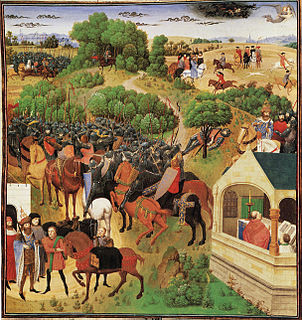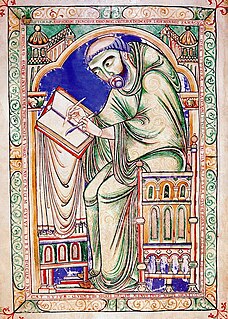Protheselaus is a verse romance composed in Anglo-Norman by Hue de Rotelande at the end of the 12th century. Hue lived at Credenhill near Hereford, according to his earlier poem Ipomedon . Protheselaus is dedicated to Hue's patron Gilbert fitzBaderon, lord of Monmouth. Gilbert died in or just before 1191: that date is a terminus ante quem for the completion of Protheselaus.
Anglo-Norman, also known as Anglo-Norman French, was a dialect of French that was used in England and, to a lesser extent, elsewhere in the British Isles during the Anglo-Norman period.
Hue de Rotelande was an important Cambro-Norman poet writing in Old French at the end of the 12th century.

Credenhill is a village and civil parish in Herefordshire, England. The population of this civil parish taken at the 2011 Census was 2,271.
It is a sequel to Ipomedon in the same sense in which sequels were composed to the chansons de geste: Protheselaus is introduced as the son of Ipomedon, he has adventures that are similar to his father's, and faces similar problems. He is deprived of his inheritance. He is in love with Medea and believes (wrongly, it appears) that she hates him. With the help of Dardanus and Melander he attempts to conciliate her and travels through distant lands to prove his knightly prowess, then returns and enters her service in disguise. He travels to Burgundy, defends Ismeine, is made prisoner by the "Maiden of the Isle" (Pucele de l'Isle), finally escapes, recovers his inheritance and marries Medea.
Although Protheselaus is a continuation of the story of Ipomedon it has a different atmosphere In Ipomedonte auctor. In place of the satire, burlesque and occasional eroticism of Ipomedon the characters in Protheselaus -- especially the hero himself and his friends Dardanus and Melander -- are virtuous, selfless, and motivated by concern for the wellbeing of others. [1] By contrast with Ipomedon, Protheselaus attracted relatively few readers in later times and was not translated into other languages.
Ipomedon is a romance composed in Anglo-Norman verse by Hugh de Rotelande in the late 12th century at Credenhill near Hereford. In the sequel Protheselaus, which must have been composed slightly later, Hue acknowledges as his patron Gilbert fitzBaderon, lord of Monmouth. Gilbert's death in or just before 1191 gives an approximate terminus ante quem to both romances.
Huon of Bordeaux is the title character of a 13th-century French epic poem with romance elements.

The chanson de geste is a medieval narrative, a type of epic poem that appears at the dawn of French literature. The earliest known poems of this genre date from the late eleventh and early twelfth centuries, before the emergence of the lyric poetry of the trouvères (troubadours) and the earliest verse romances. They reached their apogee in the period 1150–1250.
Anglo-Norman literature is literature composed in the Anglo-Norman language developed during the period 1066–1204 when the Duchy of Normandy and England were united in the Anglo-Norman realm.
Durendal or Durandal is the sword of Roland, legendary paladin of Charlemagne in French epic literature. It is also said to have belonged to young Charlemagne at one point, and, passing through Saracen hands, came to be owned by Roland.
Medieval French literature is, for the purpose of this article, literature written in Oïl languages during the period from the eleventh century to the end of the fifteenth century.
Naimon, Duke of Bavaria, also called Naimes, Naime, Naymon, Namo, and Namus, is a character of the Matter of France stories concerning Charlemagne and his paladins, and appears in Old French chansons de geste and Italian romance epics. He is traditionally Charlemagne's wisest and most trusted advisor.
Cath Palug, also Cath Paluc, Cath Balug, Cath Balwg, literally "Palug's cat", was a monstrous cat in Welsh legend, given birth in Gwynedd by the Henwen the pig of Cornwall; the cat was later to haunt the Isle of Anglesey, and said to have killed 180 warriors when Sir Kay went to hunt it on the island.
Romance of Thebes is a literary subject that has been treated in several languages.

Amis et Amiles is an old French romance based on a widespread legend of friendship and sacrifice. In its earlier and simpler form it is the story of two friends, one of whom, Amis, was sick with leprosy because he had committed perjury to save his friend. A vision informed him that he could only be cured by bathing in the blood of Amiles's children. When Amiles learnt this he killed the children, who were, however, miraculously restored to life after the cure of Amis.

This article presents lists of the literary events and publications in the 12th century.
The Karlamagnús saga, Karlamagnussaga or Karlamagnus-saga was a late-thirteenth-century Norse prose compilation and adaptation, made for Haakon V of Norway, of the Old French chansons de geste of the Matter of France dealing with Charlemagne and his paladins. In some cases, the Karlamagnús saga remains the only source for otherwise-lost Old French epics.
Gormond et Isembart is an Old French chanson de geste from the second half of the eleventh or first half of the twelfth century. Along with The Song of Roland and the Chanson de Guillaume, it is one of the three chansons de geste whose composition incontestably dates from before 1150; it may be slightly younger than The Song of Roland and, according to one expert, may date from as early as 1068. The poem tells the story of a rebellious young French lord, Isembart, who allies himself with a Saracen king, Gormond, renounces his Christianity, and battles the French king. The poem is sometimes grouped with the Geste de Doon de Mayence or "rebellious vassal cycle" of chansons de geste.
Guernes de Pont-Sainte-Maxence, also known as Garnier, was a 12th-century French scribe and one of the ten contemporary biographers of Saint Thomas Becket of Canterbury.
Nationality words link to articles with information on the nation's poetry or literature.

The Anglo-Norman romance Ipomedon by Hue de Rotelande, composed near Hereford around 1180, survives in three separate Middle English versions, a long poem Ipomadon composed in tail-rhyme verse, possibly in the last decade of the fourteenth century, a shorter poem The Lyfe of Ipomydon, dating to the fifteenth century and a prose version, Ipomedon, also of the fifteenth century. In each case, the story is taken independently from the Anglo-Norman romance Ipomedon, written in Old French by Hue de Rotelande "not long after 1180", possibly in Herefordshire, England. It is included in a list of the popular English romances by Richard Hyrde in the 1520s.

Pontus and Sidonia is a medieval prose romance, originally composed in French in ca. 1400, possibly by Geoffroy IV de la Tour Landry or by another member of the La Tour family. It is about Pontus, the son of the king of Galicia, who falls in love with Sidonia, daughter of the king of Brittany. The text is associated with the lords of La Tour because it derives the ancestors of that family, whose ancestral possessions were in Brittany, from members of the train of prince Pontus. The story is based on an earlier work, the Anglo-Norman chanson de geste Horn et Rimenhild.
Gilbert fitzBaderon of Monmouth was one of the two sons of Baderon fitzWilliam, and of his wife Rohese de Clare. When Baderon died, at some date between 1170 and 1176, Gilbert succeeded him as lord of Monmouth and holder of Monmouth Castle. Gilbert is best known as a patron of literature and it was under Gilbert's patronage that the poet Hue de Rotelande wrote his verse romance Ipomedon, which was among the most popular works in its genre in medieval England. The original text in Anglo-Norman was translated at least three times into Middle English under the variant title Ipomadon. Hue de Rotelande afterwards wrote a sequel, Protheselaus, which he dedicated to his patron Gilbert fitzBaderon.
Aiquin, subtitled La conqueste de la Bretaigne par le roy Charlemaigne, is a medieval Old French chanson de geste about the rivalry between a Saracen king, Aiquin, and the Christian emperor Charlemagne. The French medievalist Joseph Bédier called it a "consolidation of history and legend in an imposing ensemble." It survives in one fifteenth-century manuscript, BnF fr. 2233, now in the Bibliothèque nationale de France. It is usually attributed to Garin Trosseboeuf, possibly a cleric of Dol, and was probably written in the late twelfth century. It is the oldest extant French text from Brittany.





